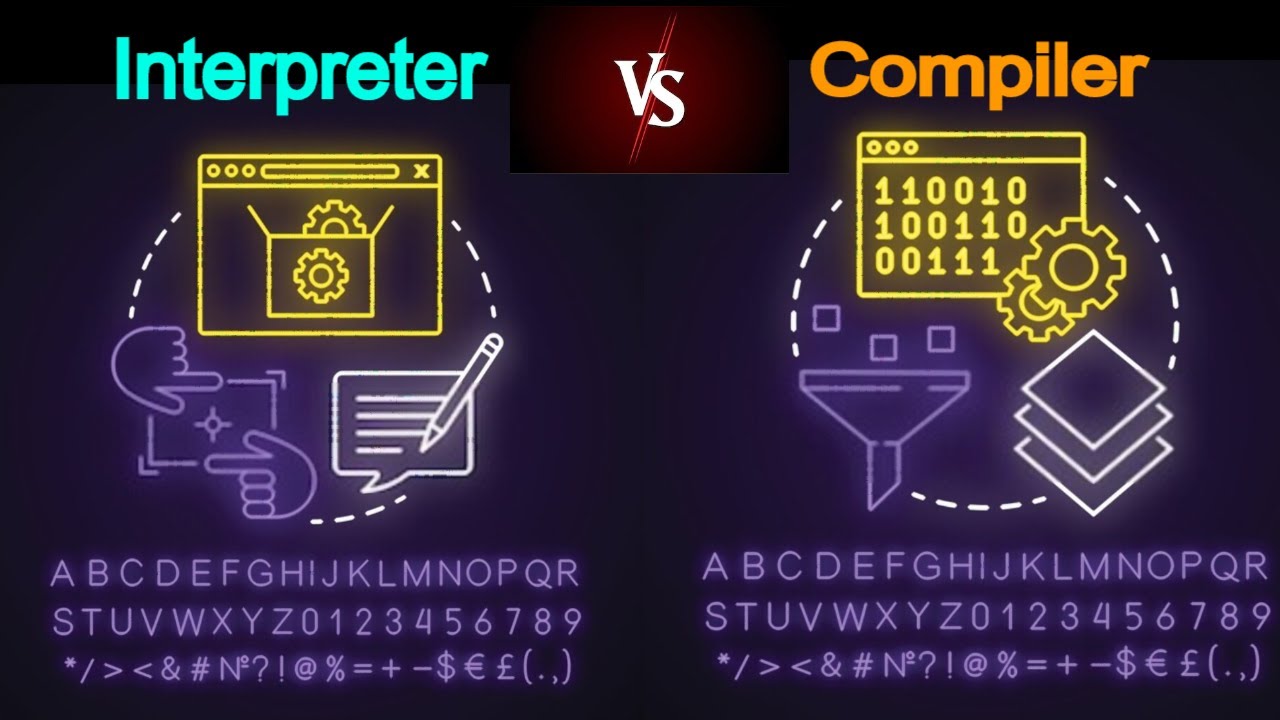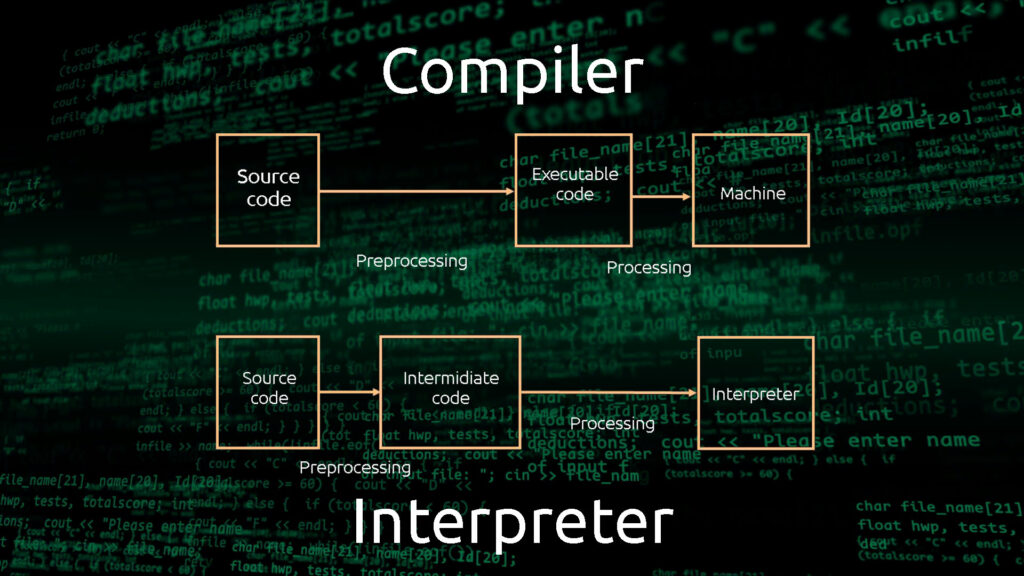Difference Between Compiler vs Interpreter

You’re not alone if you’ve never heard of it. Code written in high-level languages that can be understood by humans becomes second nature to developers. A program can only be interpreted by computers if it is written in machine code, a binary representation.
We came up with two ways to communicate with a computer in its non-human language: interpreters and compilers. Most of us have no idea what these things even are, even though they’re an essential part of our everyday coding routines.
In this essay, I’ll explain the process of converting a high-level language into machine code that can be executed. Compiler vs interpreter, the two main players in this game, will be the focus of my analysis, and I’ll dissect the related concepts.
The Journey from High to Low Language
For a long time, computer programs have employed compilers and interpreters to change code. However, their methods differ:
A compiler converts high-level programming languages like Java, C++, and C# into lower-level languages like machine code, object code, and assembly language (binary 1 and 0 bits). It does the conversion in advance of the program’s execution.
When a program is executing, an interpreter interprets each line of code one by one. You’ve probably relied on interpreters at some time in your job without even realizing it.
[Also read: HP vs Lenovo]
There are Benefits and Drawbacks to Using a Compiler vs Interpreter
The interpreter just needs a single line of code to examine, while a compiler needs a whole programme and a significant amount of time to do it.
Compiling code is quicker than interpreting it.
After compilation, a compiler shows all faults. It will not compile if it contains errors. The interpreter, on the other hand, shows the faults in each line sequentially.
Interpretation is not a substitute for compilation.
The inclusion of interpreters in compilers is possible for speed and memory savings reasons.
What is the Difference Between Interpreter and Compiler?

Difference between compiler and interpreter It is common practice to programme computers using high-level languages that laypeople can understand. Words and phrases from human languages, like English, can be found in high-level languages. A computer program’s high-level programming language is frequently referred to as “source code.” These high-level programming languages, on the other hand, are not understood by the computer. For the task at hand, it only knew how to process binary data in the form of machine code.
High-level language instruction must be translated into machine language before it can be executed by a computer. The source code programming language is converted to machine code using a compiler vs interpreter or both. When a high-level language is translated into a machine language that a computer can comprehend and perform tasks as directed by the programme, it is called a compiler vs interpreter. However, the working method and steps of a compiler vs interpreter are not the same in every case. To get a better understanding of the distinction between a compiler vs interpreter, we’ll first cover the basics.
What are Compiler and Interpreter?
Compiler
In a compiler, source code is transformed into machine code according to the rules of a programming language’s grammar. The software generates error warnings, and you must repair them yourself by correcting the syntax of the programme. If your programme is devoid of errors, the compiler will translate your source code into machine code. Machine code is generated from source code at once by a compiler. Finally, your programme is ready to go.
Analysis and synthesis are two distinct phases in the source code compilation process.
- As part of the front-end phase of a compiler, a compiler analyses a source code to find faults in grammar, syntax, and semantics before creating intermediate code. In the compilation process’s analysis stage, lexical analysis, semantic analyzer, and syntax analyzer are all used.
- It’s during Synthesis that code that was analyzed in the Analysis Phase is optimized and turned into target machine code. Tasks like code optimization and creation are part of the compilation process’ synthesis phase.
Compiler Advantages and Disadvantages
There are many distinct object codes that may be generated by a compiler when translating source code into machine code. Thus, the amount of time it takes to run the code is greatly reduced. When you define compiler in computer, you must go back to your source code to make changes to the program.
[Also read: Step By Step Guide On How To Copy And Paste On Mac]
Interpreter
It is also possible for an interpreter to be a piece of software that translates between machine and human language. An interpreter transforms the high-level programming language into machine code one line at a time while interpreting and executing the programme.
The Benefits and Drawbacks of Using an Interpreter
Working with source code is made simpler thanks to the interpreter. As a result, it is quite popular, particularly among those just starting out. Only machines with the same interpreter can execute interpreter-based applications. Let’s differentiate between interpreter and compiler.
The terms “compiled language” and “interpreted language” are both used to describe high-level programming languages. They may have both compiled and interpreted implementations in reality, though. Despite the presence of C interpreters, C is referred to as a compiled language. JIT compilation is now standard practice for all current JavaScript engines, which started off as basic interpreters.
The Different Types of Translators
As early as 1952, interpreters were employed to make programming easier and to convert between low-level machine languages. Lisp was the first high-level language that could be interpreted. Other programming languages that make use of interpreters include Python, Ruby, Perl, and PHP.
Following is a list of interpreter kinds that is not all-inclusive:
1. Interpreter for the Bytecode
Just in time compilation and bytecode interpretation are blurring the lines between compilers and interpreters.
“Because each instruction in a bytecode interpreter begins with a byte, bytecode interpreters may hold up to 256 instructions. As you may imagine, there are many complex bytecodes that need several bytes.
2. Interpreter for Threaded Code
Threaded code interpreters employ pointers instead of bytes, unlike bytecode interpreters. Instructions may or may not be accompanied by parameters, but they all refer to some kind of function or set of instructions. Memory and address space constraints restrict the number of instructions that may be executed.
An example of threaded code is Forth, which is often used in open-source operating systems. An “F code” bytecode is generated from the source code, which is then interpreted by a virtual machine.
3. Interpreter for an Abstract Syntax Tree
AST, or Abstract Syntax Tree, may be familiar if you’re a TypeScript developer with knowledge of the TypeScript architecture.
- The architecture of the TypeScript transpiler
- Architecture for TypeScript Transpilers
- To run a programme or produce native code just in time, an AST technique involves converting the source code into an efficient abstract syntax tree.
- The global programme structure and relationships among statements are preserved by AST. Because of this, AST is a superior intermediate format for just-in-time compilers than bytecode representation, allowing the system to do better analysis while it is running.
AST, on the other hand, places an additional burden on interpreters. The process of traversing the abstract syntax tree is slower for interpreters than for those that write bytecodes.
4. Compilation Made at the Last Minute
As the name suggests, JIT compiles the intermediate representation to native machine code only when it is needed.
A Compiler Type
- It’s a compiler that runs on an operating system that is different from the operating system on which the code it creates will be executed.
- Compiler output that may be used on the same kind of machine and operating system as the compiler itself (a “native compiler”).
- Bootstrap compiler: a compilation tool designed to work with the target language.
Compiler/Decompiler
Code is translated from a low-level language to an upper-level one via a decompiler.
5. A Source-to-Source Compiler
Basically, it is a tool for translating between high-level programming languages. Transcompilers, or transpilers, are also known as trans compilers.
Examples:
Converts C/C++ to JavaScript with a tool called Emscripten
Babel is a tool for converting ES6+ JavaScript code to ES5.
Cfront is a classic example of a C++ compiler (from around 1983). For this purpose, it employed C as its target language and produced C code that had no indent style and no nice C intermediate codes.
[Also read: Everything To Know About Procreate For Windows]
6. A Rewriter of Language
This is generally software that converts phrases into another language without changing their meaning.
7. Compiler for Bytecode
Code that may be translated by a bytecode interpreter or virtual machine is generated by a high-level compiler.
Java and Python are interpreted language bytecode compilers are two good examples.
8. Compiler that Runs Only When Needed (JIT Compiler)
Compilation programming is delayed until runtime in a JIT compiler. Typically, it’s a part of an interpreter that runs.
Examples:
- LISP is credited as being the first to publish a JIT compiler.
- In the 1980s, Smalltalk and similar languages began using the latter strategy.
- Java, the.NET Framework and Python are just some of the current languages where JIT compilation has become a common practice.
- The procedures involved in compiling Java
- The functionality of the Java Runtime Environment
- Java bytecode (a highly efficient collection of instructions) is first compiled and turned into.class files, then executed by a bytecode interpreter, and finally translated into machine code by the JIT compiler.
- There are two ways Java bytecode may be processed: either at runtime by the virtual machine, or turned into native code at load time or run time. After the first startup period, modern JVM implementations employ the compilation process, and the performance is comparable to native code.
9. Compilation of AOT files
Compiling a higher-level programming language, or an intermediate representation like Java bytecode, before the runtime is known as AOT compilation.
Because it employs an AOT compiler to convert HTML and TypeScript code into JavaScript code during the development process, the Angular framework allows for quicker rendering on a browser later on.
10. Assembler
An assembler is a computer program that converts the assembly language into machine code. Putting it all together is known as an assembly. A disassembler is software that reverses the process of converting machine code to assembly language.
Utility programs for the Assembly language and Assembler
A low-level programming language that relies on machine code instructions is an assembly language (abbreviated ASM). Every assembly language is designed for a specific computer architecture because of this.
Takeaway
Code created in a high-level language may be translated into machine code by using either a compiler or interpreter. But there are compiler and interpreter differences in how and when to employ them. This information, even if you don’t plan to write the next compiler vs interpreter, will help you increase your understanding of the tools you use every day as a developer.





